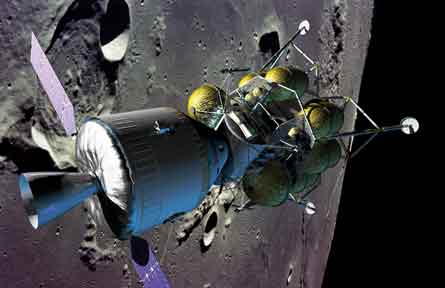NASA has renamed its 25t four- to six-astronaut Crew Exploration Vehicle Orion and revealed details of the Constellation programme's Lunar Surface Access Module (LSAM).
NASA expects to launch Orion on the recently renamed Ares I crew launch vehicle for International Space Station missions from 2014 and Moon missions no later than 2020. The LSAM will be launched on the heavylift cargo launch vehicle, now called Ares V, along with the Earth departure stage, and both would dock with Orion in low-Earth orbit.
|
|---|
| Orion would enter lunar orbit docked to the LSAM |
It is likely that NASA will also rename the LSAM, which will undock from Orion and carry out a lunar de-orbit burn to achieve a transfer orbit coast with an apolune of 100km (60 miles) and a perilune of 18km. At the perilune the LSAM would begin its powered descent phase with braking burns followed by a pitch over and throttle down to enter the terminal descent phase. This compares with the 1969 Apollo 11 mission when, according to NASA, the mission's Eagle lunar lander was to undock from the Columbia command module at 110km and powered descent initiation was to be at 15km.
The LSAM will use autonomous landing and hazard avoidance technology (ALHAT), which is part of the flight-control system, for its descent control. Details of the descent profile were made public in the ALHAT's operational concept description document, published on 18 August.
Once the LSAM undocks from Orion it would follow its pre-programmed descent sequence using vehicle flight and system data to calculate, using ALHAT, a trajectory to the pre-selected landing point.
ALHAT will detect hazards in the landing area, such as boulders, and the LSAM's autonomous flight manager (AFM) will monitor the possible threat from its exhaust plume to the landing location or existing assets near to it. If a threat were detected, the AFM, operating in either fully automatic mode for robotic cargo delivery or requiring astronaut confirmation of certain decisions, would dynamically replan the descent.
Information would be provided to astronauts via displays and, if the AFM did calculate that an abort was necessary, the operator could still override it. With an override, the AFM would require an astronaut's inputs for the new landing constraints.
The ALHAT operational concept description identifies mission phase initiation and approval, landing planning adjustments, landing site re-designation, aborts and fault identification and recovery as astronaut intervention points.
For guidance and navigation, ALHAT will use inertial sensors and a terrain relative navigation (TRN) system. The TRN will detect lunar surface features and compare them with an electronic map.
This map will be generated using data from the Lunar Reconnaissance Orbiter, which is to be launched in 2008.
Source: Flight International
























